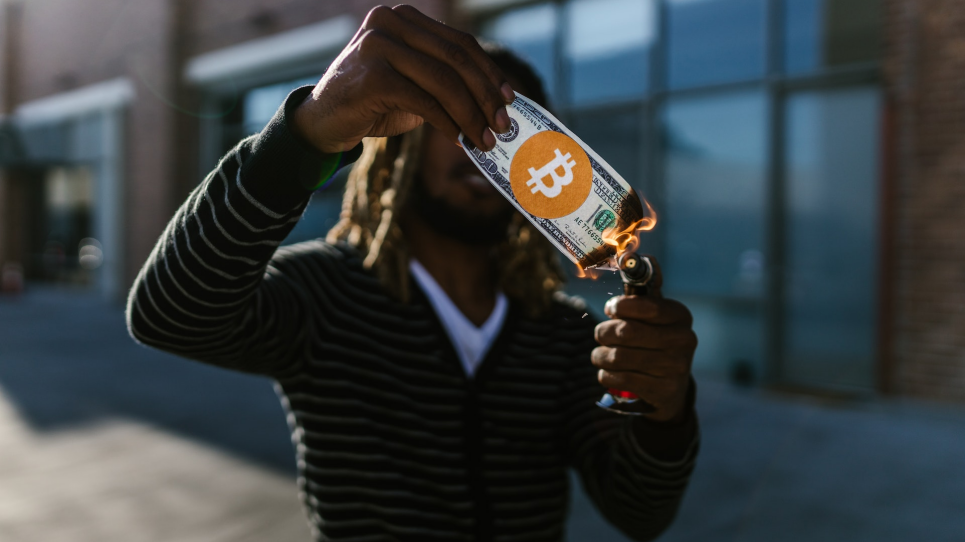HUBburger® Group Services
Log in
| admins |
| StreetTadeusza Tylewskiego 44 |
| 80-169Gdansk |
| Poland |
HUBburger® Group Services
Your convenient hemp footprint
Business
Blockchain technology is spreading to more and more sectors and changing the approach to understanding and implementing tokenization

pic. pexels
Is this just a temporary splurge on new opportunities, or a long-term trend that will shape the future?
The origins of tokenization
To consider the future of tokenization at all, it is important to understand its past. The historical use of tokens dates back, for example, to the British Empire in the 17th - 19th centuries, when fiat currency was not widely available. Tokens at the time were used as an alternative to coins or simply to help purchase certain items. A similar situation occurred in Turkey, as early as 3,000 years ago. At its site, scientists have discovered clay tokens in various shapes. They are believed to have served as a means of payment or a tool for storing value. Sound familiar? Therefore, the identity of tokens as an important instrument for the exchange of goods, services and value becomes quite obvious.
Over time, the concept of tokenization has penetrated e-commerce. It is now an important tool in modern security protocols and is used to protect users' payment and card information. Using tokenization, online merchants and payment service providers can transmit card data in encrypted form.
Blockchain and tokenization
While tokenization applications have traditionally helped secure users' payments and personal financial information, they have found a whole new direction thanks to blockchain technology. It is the emergence of blockchain-based tokenization that is one of the reasons for the increasingly widespread assumption that our future will be stokenized. This term in the context of the aforementioned technology refers to the highly secure process of transferring property rights or financial assets in the real world to digital assets.
It should be noted that blockchain networks provide encryption and traceability for each transaction. As a result, blockchain-based tokenization offers a transparent, secure and highly progressive approach to managing any asset.
Blockchain helps to securely and efficiently tokenize various real assets and companies. Interestingly, the process logic provides an ideal justification for use cases in many different industries.
Is tokenization the future?
The main advantage of blockchain is decentralization. Current times are characterized by the total opposite - excessive centralization by big companies and government institutions. This significant problem manifests itself in the form of outdated and complicated systems, time-consuming bureaucracy and lack of transparency of the various entities. Decentralization can help optimize any process, automating it and reducing the chain of intermediaries.
One tokenization concept in blockchain that may have the potential to have a significant impact on the future is STO - Security Token Offering. Security token offerings have emerged after a boom of several years for ICOs - Initial Coin Offerings. The term means raising money for a project using the sale of their native tokens. Many startups promised huge returns to investors deciding to back the concept in the early stages of development. However, the coins usually had no real value beyond purely theoretical assumptions, and 70% of the investment offers turned out to be scams. A stable future cannot look like this. Secutiry token offering, or STO for short, refers to a resource that is the digital equivalent of securities. Their purchaser thus receives ownership rights to a specific product.
Indeed, tokenized resources can represent full or partial ownership of other resources, such as real estate, works of art and other assets. An important advantage is that any investment can be divided into multiple tokens. This allowed small investors to explore abundant opportunities in the investment market without joining mutual funds.
Most importantly, tokenization could provide simpler investor registration procedures, as well as lower the final threshold for participation in investment markets. As a result, this technology can offer significant prospects for creating a securities market without the existence of an exchange or intermediaries. The risk of keeping funds out of the portfolio is therefore reduced.
The scope of tokenization is virtually unlimited
Now let's take a look at the industries that are already taking advantage of tokenization capabilities. The best-known examples of blockchain-based projects already exist, for example, in the healthcare sector. Tokenization of personal health records and pharmaceutical supplies holds adequate promise for continued tokenization in this sector in the future. IBM is working with Hedera Hashgraph to create turnkey solutions for the healthcare industry, including for global vaccine management.
Tokenization has also found its way into payments, asset management, real estate, data management, insurance, graphics, and the sale of antiques and collectibles. Tokenization can even make an individual's assets include his social contacts and professional skills. In theory, we can stocenize our entire life experience in the form of soulbound tokens. This recently fashionable term means tokens associated with the soul of a particular individual. Such badges could contain literally all the information about us, from the courses we have taken to our approach to paying off loans and other obligations. In the future, any intangible entities such as time, ideas (tokenization of patents) or skills may also be tokenized.
Applications of tokenization in various sectors
Discussion around blockchain applications has begun to gather momentum. As we mentioned earlier, you can stokenize the property you are selling or obtain ownership of a fraction of a work of art. One of the industries where the use of blockchain could significantly impact further development is agriculture. Tokenization supports farmers in pre-selling future crops to obtain financing as early as the plantation establishment stage. It can also help athletes sell the rights to their income in the future. While all of these capabilities have the right potential, the most common use case for tokenization has been identified in CBDCs, the digital currencies of central banks. In this case, the digital asset is tied to central banks' fiat money. About 100 countries are currently working on an electronic version of their currency.
Advantages of tokenization
In order to find out how the tokenization of the future will work, it is important to understand its many advantages. The benefits of asset tokenization can clearly demonstrate the reasons why companies or users choose to do so.
Information security
The most important value advantage associated with tokenization relates to the utility of tokens only in the systems in which they operate. This enables better protection of sensitive data. In the case of tokenization, the encrypted text does not contain personal data. Therefore, no person with access to the ciphertext can steal sensitive user information or use it for malicious purposes.
Fractional ownership
Tokenization of assets allows them to be divided into multiple parts. As a result, token shares help transfer ownership. Users do not need to physically divide assets into multiple parts to enable trading. As such, tokenization may redefine conventional norms of asset ownership, encouraging the possibility of fractional ownership.
Most importantly, fractional ownership can also open the door to traditionally illiquid markets for investors. This practice also creates an equal opportunity society. You don't have to have a lot of money to invest in real estate. Blockchain opens up the possibility to safely invest in, say, a 1 sq. ft. apartment. Once the deal is done, you can reap the benefits appropriate to the amount of funds invested.
New quality of transactions
Stocenized future is also a significant opportunity to improve the quality of transactions. The aforementioned fractionality can provide better prospects for ownership, with tokenization also improving the speed of transactions involving real assets. Tokenization helps improve the security of trading in physical assets while providing greater simplicity and convenience.
By introducing the basic precedent of blockchain technology, tokenization helps reduce the need to interact with intermediaries. Tokenization of assets in exchange trading can help solve one of the serious problems, i.e.. redundant formalities. In addition to eliminating them, tokenization also enables a flexible approach to selling and buying assets. Stock market investors would no longer have to rely on asset management companies. All transactions could call back from private wallets.
Concerns about the future of tokenization
However, it is important to consider the possible failures associated with tokenization before inferring its future. The possibility of its widespread adoption depends largely on understanding and solving existing problems. Here are some of the pitfalls that could affect the development of a blockchain-based future.
Trust issues and lack of regulation
Trust issues and lack of regulation often arise with tokenization. It should be noted that the creator of the token cannot act as a regulated financial institution. As a result, securing property is unlikely to have documented evidence, limiting its validity in court. A revolution is needed when it comes to the law related to tokenization and an increase in the number of entities involved in this field.
Business models in tokenization must rely heavily on authority and trust. On the other hand, these patterns are commonly seen in scenarios related to bubble formation. Investors in financial markets are subject to oversight by regulators to reduce concerns about fraud. Regulators may have limited authority over stock tokenization, especially when vendors avoid having their product recognized as security tokens.
Lack of infrastructure
Another obstacle to tokenization may be the lack of a working tokenization system for physical assets or financial entities available on the market. Tokenization of assets involves some significant technological requirements. For example, the current outdated IT infrastructure may not be able to cope with the logic of smart contracts, automated contracts based on the IFTTT scheme - if this then that. However, adapting to the new standards can bring tangible benefits.
Upcoming regulations
However, it seems that the above problems will soon be solved. Various governing bodies are preparing to introduce regulations. Both local, national and global legal frameworks are being refined. The International Organization of Securities Commissions (IOSCO), in cooperation with the Bank for International Settlements and the Committee on the. The Committee on Payments and Market Infrastructures (CPMI), issued guidelines on cryptographic payment systems a few months ago. The coming months should already bring an answer to the question of how the future will be shaped based on blockchain. What is worrying, however, is that some countries, including Poland, still seem to be ignoring the fact of this digital revolution. Let's hope that in our country at the highest levels, discussions on this topic will also soon emerge.
Future is now
Is our future based on blockchain? All indications are that it is. Tokenization provides the right range of unlimited possibilities in various sectors and gives a significant advantage to those applying it. However, it must be remembered that the existing challenges must find reliable solutions. However, it is perfectly normal that a revolution takes time. Universal tokenization is a relatively new concept and requires some improvement and adjustment under it.
If you think this is an interesting article, it will be my pleasure if you share it with others.
Greetings
| Maja Wirowska |
| Maja Wirowska |
| Street |
- Share
tags
Recent
Health
Meditation and working with one's own mind is an ancient practice that has thousands of years of roots in many cultures and traditions.
Business
HUBburger.com CEO Maciej Sagal in an interview with The Birb Nest channel
The festival season can be seen around the corner, but at this event, in addition to the excitement of performances by Polish hip-hop stars - you will also be able to enjoy activities in a special hemp zone HUBburger.com
top3
Health
Author
| Justyna Moraczewska |
| Justyna Moraczewska |
| Street |
Date of publication 2023-02-10
Ecology
Author
| Monika Sobczak |
| Monika Sobczak |
| Street |
Date of publication 2023-02-10
Health
Author
| Monika Sobczak |
| Monika Sobczak |
| Street |
Date of publication 2023-02-15
Eco-friendly detergents, soaps and powders are a green alternative
Health
Author
| admins |
| Hanna Wolska |
| StreetTadeusza Tylewskiego 44 |
| 80-169Gdansk |
| Poland |
Date of publication 2023-01-10
New research leaves no doubt
Future
Author
| admins |
| Hanna Wolska |
| StreetTadeusza Tylewskiego 44 |
| 80-169Gdansk |
| Poland |
Date of publication 2023-01-09
Ecology
Author
| admins |
| Hanna Wolska |
| StreetTadeusza Tylewskiego 44 |
| 80-169Gdansk |
| Poland |
Date of publication 2023-01-09
Advertising
Recommended
Business
Web3/NFT project through which users receive casback in the form of tokens for purchases from subscribed vendors
Health
Protein powder is one of the most popular supplements used for weight loss and sports activities. Protein is essential for both building muscle mass and burning fat. Vegan proteins are becoming increasingly popular, among them proteins derived from hemp seeds. The easiest method of protein supplementation is a delicious and nutritious shake that you can quickly make and take with you wherever you want.
News
Oslo will have world's first all-electric public transport system. In the race for a better environment and population health, Norwegians are on the final straight.
News
Oslo will have world's first all-electric public transport system. In the race for a better environment and population health, Norwegians are on the final straight.
Podcast
We have selected for you the most interesting, in our opinion, episodes of podcasts on the subject of hemp, but not only. We also reserve space here for our audio production, which is slowly sprouting in our editorial office.


































Comments